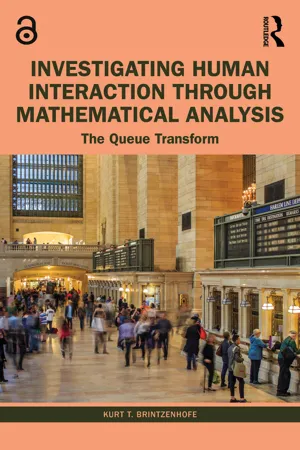
Investigating Human Interaction through Mathematical Analysis
The Queue Transform
- 202 pages
- English
- PDF
- Available on iOS & Android
Investigating Human Interaction through Mathematical Analysis
The Queue Transform
About This Book
Investigating Human Interaction through Mathematical Analysis offers a new and unique approach to social intragroup interaction by using mathematics and psychophysics to create a mathematical model based on social psychological theories.
It draws on the work of Dr. Stanley Milgram, Dr. Bibb Latane, and Dr. Bernd Schmitt to develop an algebraic expression and applies it to quantitatively model and explain various independent social psychology experiments taken from refereed journals involving basic social systems with underlying queue-like structures. It is then argued that the social queue as a resource system, containing common-pool resources, meets the eight design principles necessary to support stability within the queue. Making this link provides a means to advance to more complex social systems. It is envisioned that if basic social systems as presented can be modeled, then, with further development, more complex social systems may eventually be modeled for the purpose of identifying and validating social structures that might eventually support stable governments in our common environment called Earth.
This is a fascinating reading for academics and advanced students interested in political theory, detection theory, social psychology, organizational behavior, psychophysics, and applied mathematics in the social and information sciences.
The Open Access version of this book, available at www.taylorfrancis.com, has been made available under a Creative Commons Attribution-Non Commercial-No Derivatives 4.0 license.
Frequently asked questions
Information
Table of contents
- Cover
- Half Title
- Title
- Copyright
- Dedication
- Contents
- List of Figures
- Preface
- Acknowledgments
- Introduction
- 1 Social Psychology and Psychophysics: Laying the Foundation
- 2 Milgram’s Drawing Power of Crowds and Social Impact Theory
- 3 Revisiting Milgram’s 1978 “Response to Intrusion into Waiting Lines” Experiment
- 4 Applying the Queue Transform
- 5 From the Queue to the Commons
- 6 An Algebraic Group in Social Space
- 7 History as Data
- Appendix A: Deriving Minimum Queue Length Based on Milgram et al. (1986) Data
- Glossary of Variables and Notation
- Index